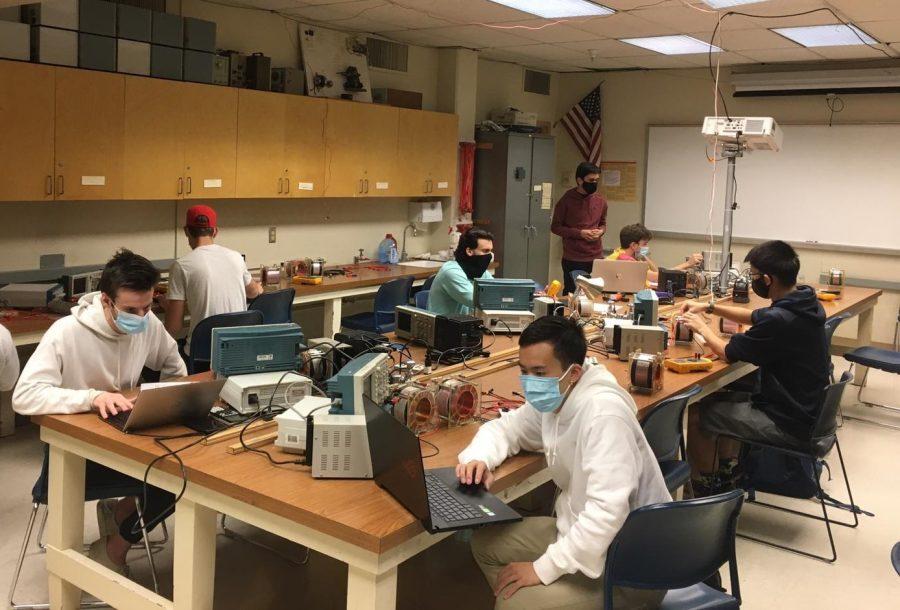Centralized vaccination efforts around the nation and in the state of Arizona have substantially reduced the burden of COVID-19 cases. This has allowed academic institutions to lift many restrictions and start paving the way back to normality.
While there are some concerns about SARS-CoV-2 variants, namely the Delta variant, the University of Arizona still plans to start in-person classes this coming fall semester. For many students, this means going back to the lab and getting to work.
Some students must complete substantial lab coursework and gain lab experience as part of their major. However, during the pandemic, access to labs was greatly restricted. Although virtual alternatives to lab work were implemented, many students felt that this approach was not sufficient.
“I believe most students would agree with me when I say that in-person labs are much more engaging than virtual labs,” Anthony Nunez, a junior pursuing a major in physiology and a minor in biochemistry, said via email. “There is nothing worse than joining your [organic chemistry] lab zoom session just to stare at molecules all day without being able to actually play with them.”
An important aspect of in-person lab courses is being physically present when experiments run smoothly or when mistakes are made. This hands-on component is what makes these courses some of the most engaging for many students.
For Miriam Heras, a junior pursuing a major in neuroscience and cognitive science as well as a major in business administration, in-person labs are essential to her education.
“I am a hands-on and visual learner. Being able to attend an in-person lab was very important for me to feel comfortable and successful in the class. The purpose of labs is to apply the knowledge you have learned in lecture into the real world, or at least a physical and hands-on experience,” Heras said via email.
RELATED: UA College of Medicine selected for an internship program
Currently, the university is entering stage 3 of the reentry classification system. This stage allows in-person and flex in-person courses to have up to 100 students present. For many lab courses, this means that instruction will be expanded and that students will have more time available in the lab. During the peak of the restrictions, many lab courses were suspended, and those that were not had a reduction of time in the lab.
For Nunez, the time provided in the lab during the pandemic was not sufficient to complete certain lab protocols. He said that in previous lab courses he felt that he was “cramming a 3-hour lab session into 1 hour.”
Despite these and many other limitations, virtual sessions did provide some advantages. For Sohail Daulat, a junior pursuing a major in physiology and a minor in Spanish, the flexibility of virtual education made some of his lab courses more bearable.
“Virtual labs allowed for me to do the lab from wherever I [was], which was really convenient because it meant that I didn’t have to run all the way to [lab] and set up my experiment,” Daulat said via email. “With virtual [lab] I could just open up my laptop and watch it happen.”
Nunez stated similar benefits. “What I did like most about virtual labs is how easily accessible all of the material was whether it be experiments, recordings to look back on, or even communication with your [teaching assistant]. From my personal experience, I felt that virtual labs encouraged [teaching assistants] to really stay on top of all the material, which set a good example for me and other students to follow.”
Transitioning to in-person instruction does come with some risks. Heras said she was particularly concerned about the fact that mandatory COVID-19 testing has been lifted.
“Given that there are a few new variants, I am concerned that lifting mandatory testing might have repercussions when we return to in-person classes in the fall,” Heras said.
For Nunez, the pandemic has shown how unpredictable COVID-19 can be. “What worries me the most about returning to school this fall with less restrictions is the possibility for things to suddenly take a drastic turn once again … ,” Nunez said. “How can we be comfortable with less restrictions but with so much uncertainty?”
Daulat also expressed concerns about shifting education to in-person formats only.
“What worries me about going back to campus after the restrictions have been lifted is the fact that I actually have to walk and be physically present if I want to do something. Which sounds weird to say, but during the pandemic everything was online, which led to me having back-to-back meetings frequently without worrying about running from one side of campus to another,” Daulat said.
These concerns are not unique to just lab courses. Many students, faculty and staff have shared hesitations about lifting restrictions for the fall semester. In response, university leadership has taken measures to regularly update the UA community about current restrictions and changes per Centers for Disease Control and Prevention and state guidelines.
Moreover, the university will continue to offer live online and iCourse instruction formats. This is meant to provide students hesitant to return to campus the opportunity to complete all their work through online platforms.
As it pertains to in-person and flex in-person lab courses, the university plans to continue implementing strict disinfection practices, encouraging the use of masks and instituting reduced class sizes, although not to the level experienced during the peak of the pandemic.
Time will tell how the return to in-person instruction will impact the student experience. For now, many students like Nunez, Heras and Daulat said they are enthusiastic to return to a more complete in-person lab experience.
“Reflecting back, I do prefer in person lab,” Daulat said. “Most of the [benefits] of virtual lab have to do with me being lazy. If I am in person, I can have a better understanding of what I am doing, and I will enjoy the interactions more.”
Follow Andres Diaz on Twitter









